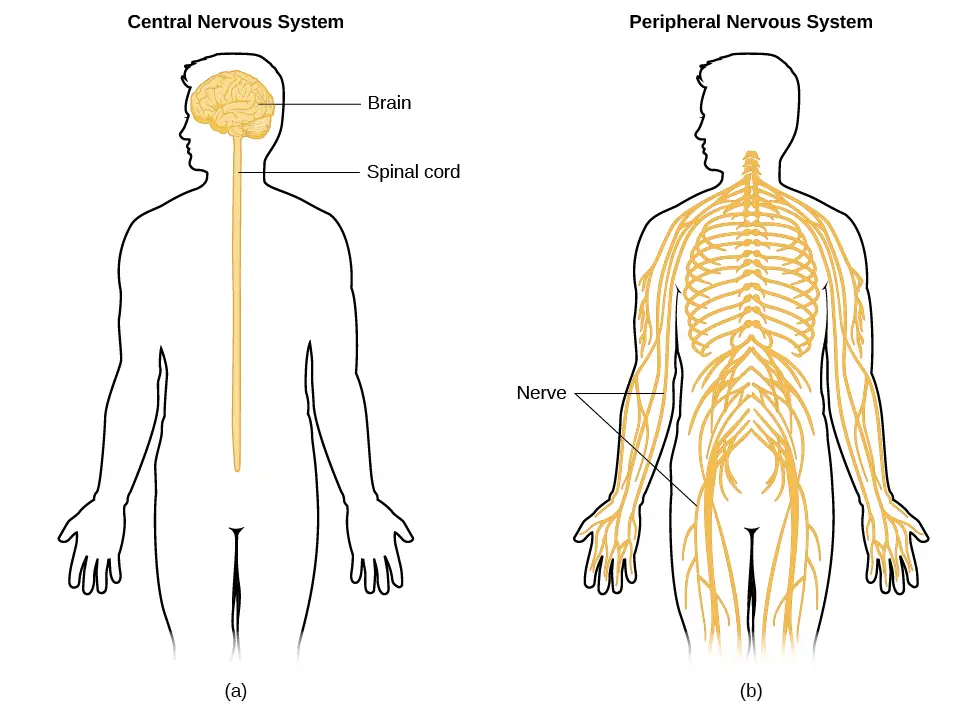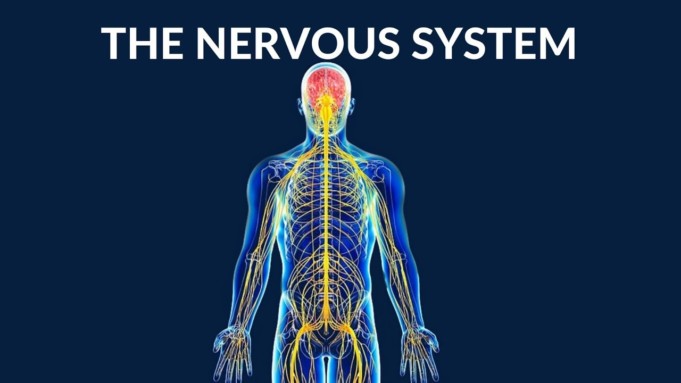Imagine billions of messengers transferring information from one point to another with each messenger varying in structure and function and existing in a complex system in which information is exchanged.
The messenger and the system in which they exist and transfer information is known as the nervous system. The nervous system is a very complex system of an animal that dictates its actions and response to stimulus by transmitting signals around different parts of its body.
It detects sensory information from the environment and works together with the endocrine system to respond to such information.
There are two main parts of the nervous system, the central nervous system (CNS), which consists of the brain and spinal cord, and the peripheral nervous system (PNS) which are all the numerous nerves that connect the central nervous system to the rest of the body.
The nerves which transmit signals from the brain are known as the efferent or motor nerves, while those that transmit signals and impulses from the body to the central nervous system are the sensory or afferent nerves.
The peripheral nervous system is further subdivided into the somatic nerves which control voluntary movement; the enteric nerves that control gastrointestinal activity; and the autonomic nerves that control the nervous system when its in a relaxed or excited state.
The unit of the nervous system is called a nerve cell or neuron. There are about 100 billion neurons in the brain. The neuron consists of a cell body that includes a nucleus and specialized parts known as axons and dendrites. These enable communication between neurons even across long distances.
When sending messages to each other, an electrical signal is sent down the length of its axon. Here it changes to a chemical signal and is released with chemical messengers known as neurotransmitters into the space between the end of one axon and the tip of the dendrite of another neuron.
This space is called the synapse. On reaching the other neuron, the signals are converted from chemical to electrical signals. This same process is repeated over and over again across the nervous system.
Nervous systems exist in most multicellular animals with sponges, mesozoans, and placozoans being the exceptions due to how simple their bodies are.
All animal species except certain species of worms have a nervous system consisting of a brain and central cords with nerves radiating from it.
The Central Nervous System
The central nervous system consists of two major parts; the brain and spinal cord
The Brain
The brain is contained within the skull and weighs approximately 1.3 to 1.4kg. It contains the neurons and supporting cells known as glia.
Two types of matter make up the brain – the grey matter which receives and stores impulses and the white matter which transports signals to and from the grey matter. The brain consists four primary parts. They are:
- The Brainstem: Also known as the medulla oblongata. It is located between the pons and spinal cord and is about an inch long. The brainstem is responsible for the flow of messages between the brain and the rest of the body and controls basic body functions like breathing, swallowing, blood pressure, heart rate, and consciousness.
- The Cerebrum: This makes up the majority of the brain and is supported by the brain stem. It is divided into two hemispheres, with each hemisphere controlling the activities of the side of the body opposite that hemisphere. The hemispheres are further divided into the frontal lobe, temporal lobe, parietal lobe, and occipital lobe. The cerebrum controls speech, emotional response, memory, and the senses.
- The Cerebellum: It is located behind and beneath the cerebrum. The cerebellum is responsible for controlling voluntary movements like posture, balance, coordination, and speech.
- The Diencephalon: This is made up of the thalamus, epithalamus, subthalamus, and hypothalamus. The diencephalon is responsible for connecting the endocrine system with the nervous system. It also manages the memory and emotions.
Other parts of the brain include the midbrain, which provides pathways from the upper and lower parts of the brain; and the pons which provide pathways between the medulla and higher brain centers.
The Spinal Cord
The spinal cord is contained inside a tube-like structure made of bones and known as the vertebral column. The column extends from the brain and is composed of 31 sections with a pair of spinal nerves coming out of each section.
Both sensory and motor nerves are located in the spinal cord. The spinal cord is about 43 cm long in women and 45 cm long in men.
The Peripheral Nervous System

The Peripheral nervous system is made up of two parts:
Somatic nervous system
This system consists of peripheral nerve fibers that pick up signals from the peripheral or distant organs such as the limbs and carry them to the central nervous system.
They also consist of motor nerve fibers that come out of the brain and take the sensory information for movement and necessary action to the skeletal muscles in response to the impulses received by the brain.
For example, when a hot object is touched, the sensory nerves carry information about the heat to the brain, which in turn, through the motor nerves, tells the muscles of the hand to withdraw it immediately. The entire process takes less than a second to occur.
Autonomic nervous system
This is divided into three parts. They are the sympathetic nervous system, the parasympathetic nervous system, and the enteric nervous system
The sympathetic nervous system controls how the body reacts in stressful situations. For example, filling the body with hormones that increases the body’s alertness, heart rate, and sending extra blood to the muscles. It is often referred to as the flight-or-fight response.
The parasympathetic nervous system is the exact opposite of the sympathetic nervous system. It relaxes the body and conserves energy, slowing down heart rate, and increasing intestinal and gland activity.
The Enteric nervous system which is the third part of the autonomic nervous system is responsible for controlling gastrointestinal activity.
Functions of the Nervous System
Sensation
One of the essential functions of the nervous system is sensation—receiving information about the environment to understand what is happening outside or within the body.
The senses are taste, touch, sight, smell, and hearing. The stimuli for taste and smell are both chemical substances, while that of touch is physical or mechanical stimuli that interact with the skin.
Light stimuli are responsible for how we see the world, and hearing is the perception of sound, which is also a physical stimulus akin to that of touch. These five senses enable us to process stimuli from the external environment
Response
The most common response produced by the nervous system upon receiving sensory information via sensory structures is the movement of muscles such as withdrawing from a hot stove or the sour and smacking sensation in the mouth when licking lime.
The responses also include the production of and secretion of sweat by the sweat glands to lower body temperature.
Responses can be divided into voluntary response which includes the movement of skeletal muscles, and involuntary response such as heartbeat, breathing, and the digestion of food.












